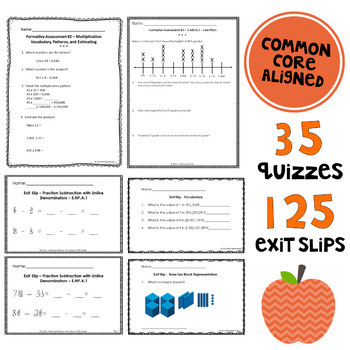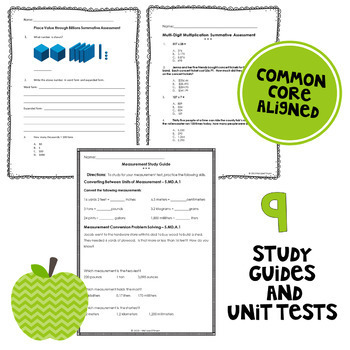Math Assessment Pack BUNDLE
- Zip
What educators are saying
Products in this Bundle (9)
showing 1-5 of 9 products
Description
Are you looking for math formative and summative assessments for the whole school year? If so, this BUNDLE is for you!
This Common Core Math Assessment Pack BUNDLE is a great deal - you'll save $15 by purchasing the BUNDLE versus the individual unit assessment packs separately.
Also, you will get all future Math Assessment Packs that I add to my store. This is a deal that can't be beat!
This BUNDLE covers Common Core State Standards from 4th through 6th grades.
The BUNDLE contains over 35 formative assessment quizzes, over 120 vocabulary word wall words, more than 125 formative assessment exit slips and a study guide and summative assessment for each of the nine packs included in the BUNDLE.
Topics included are:
► Place Value Through Billions
► Factors & Multiples
► Multi-Digit Multiplication
► Long Division
► Decimal Numbers
► Fractions
► Algebra (Order of Operations & Simple Expressions)
► Measurement
Each individual Common Core Assessment Pack is sold separately for $4-$6.
Algebra (Order of Operations/Simple Expressions)
Factors and Multiples Assessment Pack
Place Value Through Billions Assessment Pack
Decimal Numbers Assessment Pack
Multi-Digit Multiplication Assessment Pack
Fractions Assessment Pack Grade 4
Fractions Assessment Pack Grade 5
If you're just looking to purchase the exit slips portion of this product, you can buy them separately HERE.
Created by Melissa O'Bryan
Copyright © Wild About Fifth Grade
All rights reserved by author.
Permission to copy for SINGLE classroom use only.
Electronic distribution limited to single classroom use only. Please do not post this product electronically in ANY form. To do so violates the Digital Millennium Copyright Act. Additional licenses for multiple use can be purchased for half off in my store. Thank you for your support!





